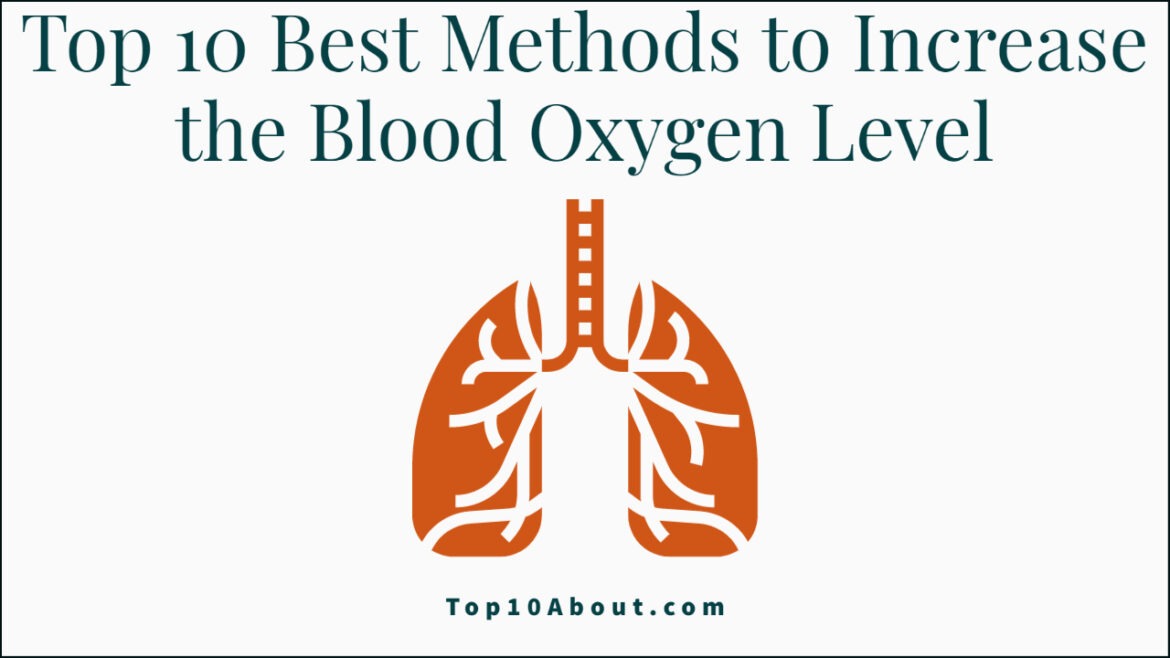Want to know how to get more oxygen and improve oxygen levels? If yes, follow these top 10 best methods to increase the blood oxygen level.
What is a Healthy Oxygen Level in Human Body?
Oxygen is the most important thing that the human body required to survive. Oxygen moves by red blood cells and a healthy blood oxygen level is normally 95% or higher. So, maintaining this level of oxygen is really decisive for the human body.
For instance, in the 2nd wave of Covid in India, most of the people were dying because of the sudden low level of oxygen even in young people. Also, the deficiency of oxygen level can be also found in chronic health conditions such as asthma, heart disease, and chronic obstructive pulmonary disease. In such patients, the regular monitoring of oxygen levels is truly crucial. So, how to check the oxygen level of the human body?
How to check the blood oxygen level?
There are basically 4 methods to check the level of oxygen which includes:-
- Pulse oximetry
- Arterial blood gas test
- Long term oxygen therapy assessment
- Hypoxic challenge / fitness-to-fly test
Now the question is, to avoid such a dangerous situation of oxygen shortage, how to get more oxygen and increase the blood oxygen level. We have shortlisted here some best methods to improve the oxygen level effectively.

Top 10 Best Methods to Increase the Blood Oxygen Level
10. Access to fresh air
One of the instant modes for oxygen access is to open the windows of the room and let fresh air enter. Properly ventilated rooms provide additional oxygen to the lungs which in turn normalizes the vital metabolic activities of our body. Whenever one feels lethargic, dizziness, palpitations, or shallow breathing this comes at first-hand rescue.
Cells need oxygen in large amounts to function appropriately. Blood cells immediately bind with oxygen and carry them to all parts of the body making us fit and hale. One can also go for a short walk-in midst of greenery and a pollution-free zone to absorb more oxygen. Also, it is highly advised to plant trees as they provide free natural oxygen to your body.
See also– Top 10 Causes of Death in Humans around the World 2021
9. Planting indoor oxygen yielding plants

Inhalation of toxic substances due to pollution has become inevitable but the supply of enough oxygen must be maintained. There are certain ferns that not only improve the quality of air also improves mental health and creates a peaceful ambiance.
Weeping fig is the best air purifying plant recognized by NASA. It has been found effective in purifying formaldehyde, xylene, and toluene from the air. Besides this, Aloe vera is a preferred indoor plant as it removes air benzene and formaldehyde. It also releases oxygen at the night.
Pathos plant, spider plant, Areca Palm, Snake Plant, Tulsi, Bamboo, Gerbera Daisy, and Chinese evergreens are also outstanding choices for indoor oxygen yielding plants. This activity truly helps to increase the blood oxygen level.
8. Indoor air filtration system installation
In case one stays at pollution prone or urban areas fresh air access gets difficult. To overcome this air filtration system is a boon. Since the quality of air inhaled also determines lung health, we must focus on the air quality we breathe.
In this, a multilayer filter system is used that comprises of prefilter, a carbon filter, an antibacterial filter, and a HEPA filter.
The HEPA filter is specialized to remove particles ranging greater or equal to 0.3 µm. The filters can trap the allergy-causing particles. Also, the purifiers lessen the negative effects of air pollution and aid in easy breathing.
See also– Top 10 Foods that Boost Immunity & Fight against COVID
7. Breathing exercise to increase lung capacity
“Anulom-Vilom Pranayama” is a highly recommended breathing exercise for the strengthening of muscles involved in respiration. It is also termed alternate nostril breathing which clears the nasal passage and facilitates easy breathing.
Bhramari is another exercise done with humming. This exercise leads to an increase of nitric oxide in the body and increases the blood flow via vessels. Nitric acid is a natural vasodilator that prevents muscle tightening.
Deep breathing is the most suggested exercise to restore the flow of oxygen and diaphragm function. It removes any obstruction, inflammation, pleural fluid, or deposition in air tracts leading to the lungs. It causes the expulsion of mucus and helps in the restoration of oxygen saturation levels.
Diaphragmatic exercise and breathing by pursed-lip are also beneficial exercises when it comes to the increased oxygen level in humans.
6. Yoga

Lung capacity can be enhanced by the age-old practice of yoga and pranayama. For this, Simha Kriya has been found appropriate. It also boosts immunity and underpins the respiratory system.
Tadasana, Vrikshasana, Trikonasana, Balasana, Matsayasana, Bhujangasana and Ardh Matsyendrasana are the most practiced and tested yogic postures for benefit of lungs.
These asanas will improve lung muscle and clear the unrequired secretions and enhance lung capacity by supplying increase oxygen amount.
5. Drinking plenty of water and juices
Hydration is the key to improve blood oxygen levels. When the body is hydrated it gets easy to deliver nutrients and oxygen to other parts of the body via the blood. Approximately 90% of the blood is water only.
Juices and smoothies are also the suggested fluids to remain hydrated. These are a powerhouse of minerals, vitamins, and antioxidants. Antioxidants let the body use oxygen more effectively. Drinking enough water prevents the accumulation of toxins in the body. Toxins are removed via respiration, perspiration, and excretion. In case of breathing disorder as asthma airways are restricted if water intake is not enough. This will cause low oxygen supply and worsening breathing.
4. Iron-loaded diet
It is the highly recommended remedy to enhance blood oxygen levels. Hemoglobin levels must be maintained to increase oxygen-carrying capacity and eventually healthy respiration.
Hemoglobin is a protein component of Red Blood Cells that are responsible for oxygen-carrying. It carries oxygen from the lungs and accessory respiratory organs to provide energy for the survival of the cell.
Broccoli, soybeans, spinach, red kidney beans, chicken, walnuts, green beans, carrots, and berries are some of the foods that enhance oxygen levels in the blood. Besides that, green vegetables, beetroots, and carrots aids in the relaxation of blood vessels and better blood and oxygen circulation in the body.
3. Oxygen concentrator
Another effective means of instant oxygen supply to the body in desperate situations. The instrument can generate infinite medical-grade oxygen from the atmosphere.
There is no requirement for refilling only a constant electricity supply is a must. These are capable of providing 10 liters of oxygen at the rate of per minute. They can sustain and provide relief to a person who has moderate fluctuation in its oxygen saturation level. Also, the instrument is handy and affordable. A person with not less than 85% of saturation level can benefit from the concentrators.
However, medical assistance must be availed for the quantity and timing of oxygen exposure to the concerned person.
2. Oxygen cylinder
The most available healthcare option in case of a breathing emergency as in COVID infection or other lung-associated diseases. Oxygen in these cylinders is non-contaminated. The compressed oxygen in the cylinder is 99.5% pure.
These cylinders are found in varying measures and require refilling. An oxygen cylinder is given against the medical prescription. Medical professionals decide the dose of oxygen to be given to patients.
Oxygen after release from the plant travels through the nasal cannula or mask to reach the patient. The supplemental oxygen immediately increases the blood oxygen level of the body. However, too much is also hazardous so oxygen saturation level must not exceed 110 mmHg.
1. Self-Proning

Prone positioning is the most worth activity approved by Medical Council to increase the blood oxygen level. Since the oxygen cylinders have undergone crisis in this pandemic this no-cost method has benefited many.
Patients are made to lie on their belly and an immediate rise in oxygen level can be monitored on an oximeter. The patient is made to lie for half an hour to two hours depending on the severity and requirement.
For self prone position one pillow needs to keep below the neck region, 2 pillows on the chest, and 2 pillows under the shins.
Prone position causes the alveoli of the lungs to open and aid easy breathing. Also, the prone position causes the dormant portion of the lungs to come into action and promotes easy breath. Ultimately, it helps in improving oxygen levels naturally.






